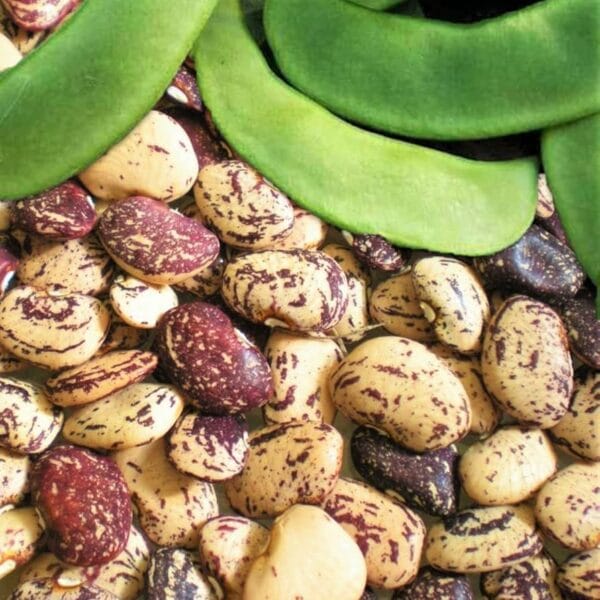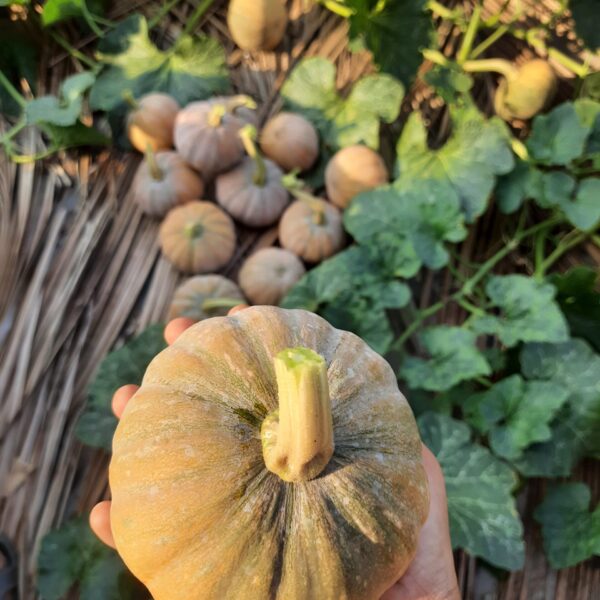Heirloom Rattail Radish seeds
Heirloom Rattail Radish seeds
Quantity: 100 seeds+
Rat tail radish (Raphanus sativus var. caudatus) is an unusual and fascinating variety of radish grown not for its roots but for its edible seed pods. This variety is also known as “pods radish” or “serpent radish.” It has a long history of cultivation in Southeast Asia and has gained popularity among gardeners and food enthusiasts for its unique appearance and culinary uses.
Our organic heirloom Rattail Radish seeds are grown without the use of synthetic chemicals or fertilizers, making them ideal for those committed to organic gardening. These open-pollinated seeds will allow you to grow your own Rattail Radishes year after year, saving seeds from your best plants.
Benefits of Organic Heirloom Rattail Radish Seeds:
- 100% Organic: Grown without harmful chemicals or synthetic fertilizers.
- Open Pollinated: Save seeds from your harvest for future planting.
- Fast-Growing: Harvest your crunchy, flavorful pods in as little as 30–60 days.
- Versatile: Enjoy the pods in a variety of ways, from raw to pickled or stir-fried.
Order Your Organic Heirloom Rattail Radish Seeds Today!
Ready to grow your own organic heirloom Rattail Radish? This unique variety is easy to grow, quick to mature, and offers flavorful, crunchy pods that will make a delightful addition to your garden and kitchen. Order your seeds todayand start growing these exciting heirloom radishes organically!
Heirloom Rattail Radish seeds
Heirloom Rattail Radish seeds
How to Grow Heirloom Rattail Radish from Seeds: A Complete Guide
Rattail Radish (often referred to as “Rat Tail Radish”) is a unique and heirloom variety of radish that is cultivated primarily for its spicy, crunchy pods rather than its root. These long, slender pods are harvested while tender and are enjoyed in salads, stir-fries, or pickled. This fast-growing radish can be an exciting addition to your garden, especially if you’re interested in organic and heirloom varieties. In this guide, we’ll cover everything you need to know to grow Heirloom Rattail Radish from seed, organically and successfully.
Why Choose Heirloom Rattail Radish?
- Unique Crop: Unlike common radishes grown for their roots, Rattail Radishes are cultivated for their pods. The pods have a crunchy, mildly spicy flavor similar to regular radishes but are typically harvested before they mature into full seeds.
- Heirloom: As an heirloom, this variety has been passed down through generations, preserving its traditional qualities, flavor, and growing traits. It is also open-pollinated, which means you can save and plant seeds from the pods.
- Fast-Growing: Rattail Radishes are quick to grow, making them a great option for home gardeners. They typically mature in 30–60 days.
- Edible Pods: Harvesting the pods is the primary goal of growing Rattail Radishes, and they can be eaten fresh, cooked, or preserved.
Step-by-Step Guide to Growing Heirloom Rattail Radish from Seeds Organically
1. Choose the Right Location
- Sunlight: Rattail Radishes prefer full sun but will tolerate light partial shade. Aim for at least 6 hours of direct sunlight per day for optimal growth.
- Temperature: These radishes thrive in cool weather, with an ideal temperature range between 50°F and 75°F (10°C to 24°C). Planting in early spring or late summer for a fall crop is best.
- Soil: Choose a well-draining, loamy soil that is rich in organic matter. The soil pH should be slightly acidic to neutral (pH 6.0–7.0). Radishes do not like heavy, clayey soil, which can cause the roots and pods to become misshapen.
2. Preparing the Soil
- Loosen the Soil: Use a garden fork or tiller to loosen the soil to a depth of 6–8 inches. Rattail Radishes need loose, well-aerated soil to allow the pods to grow freely.
- Amend with Organic Matter: Incorporate organic compost or well-rotted manure into the soil to provide nutrients and improve soil structure. Radishes don’t need heavy fertilization, but they do appreciate a nutrient-rich growing medium.
- Avoid Excess Fertilization: Too much nitrogen can cause excessive leafy growth and delay pod production. Stick to light compost or balanced organic fertilizers.
3. Sowing Rattail Radish Seeds
- When to Plant: Rattail Radishes grow best in cool weather. Plant the Heirloom Rattail Radish seeds in early spring or late summer (if planting for a fall crop). Seeds will germinate quickly in 7–14 days, and you can begin harvesting pods in just 30–60 days.
- Direct Sowing: Radishes are best direct-sown in the garden as they do not transplant well. Plant the seeds in the soil where they will grow.
- Planting Depth: Sow the Heirloom Rattail Radish seeds about 1/4 to 1/2 inch deep.
- Seed Spacing: Space the Heirloom Rattail Radish seeds about 2–3 inches apart. If planting in rows, leave about 8–12 inches between rowsto give the plants room to grow and produce pods.
- Row Spacing: Keep rows spaced at 12 inches apart to allow for easy harvesting of pods.
4. Watering and Care
- Consistent Moisture: Keep the soil evenly moist but not soggy. Regular watering is essential, especially when the plants are young and developing pods. Avoid allowing the soil to dry out completely, as this can stunt growth and impact pod development.
- Mulching: Apply a layer of organic mulch around your plants to help retain moisture, regulate soil temperature, and reduce weeds. Mulch also keeps the soil from compacting.
- Weeding: Keep the area around the plants weed-free, as weeds can compete for water and nutrients. Hand-pull weeds or use an organic mulch to suppress them.
5. Thinning and Maintenance
- Thin Seedlings: Once your seedlings are about 2 inches tall, thin them to about 3–4 inches apart to ensure proper airflow and space for pod development.
- Replant Thinned Seedlings: If you thin your plants early enough, you can replant the thinned seedlings in other parts of the garden, giving them a chance to grow and produce pods as well.
6. Pest and Disease Control
- Pests: Rattail Radishes are generally resistant to pests, but you may encounter problems with flea beetles, aphids, or root maggots. To manage these pests organically:
- Use row covers or floating row covers to protect young plants from insects like flea beetles.
- Apply neem oil or insecticidal soap for aphids or other soft-bodied insects.
- For root maggots, use diatomaceous earth around the base of plants.
- Diseases: While Rattail Radishes are fairly disease-resistant, they can be susceptible to downy mildew, clubroot, or black rot. To prevent disease:
- Practice crop rotation and avoid planting radishes in the same location year after year.
- Water at the base of the plants to keep the foliage dry, reducing the risk of fungal infections.
- Provide adequate spacing between plants for proper air circulation.
7. Harvesting Rattail Radish Pods
- When to Harvest: Rattail Radishes are grown for their pods, which are harvested while still tender and immature. The pods are typically ready to be picked in 30–60 days, depending on growing conditions.
- Harvest early for the best flavor and texture. The pods should be long, slender, and still crisp.
- Don’t wait for the pods to mature into full seeds. Once the pods start to dry out or become woody, they will lose their crisp texture and flavor.
- How to Harvest: Gently pull or snip the pods from the plant. You can harvest them individually as they mature or pick the entire plant when most of the pods are ready.
- Regular Harvesting: The more you harvest, the more the plant will continue to produce new pods. Keep picking regularly to encourage continued growth.
8. Storing and Using Rattail Radish Pods
- Storage: If you have an abundance of pods, store them in the refrigerator for up to 1–2 weeks in a perforated plastic bag or wrapped in a damp paper towel.
- Using the Pods: Rattail Radish pods are highly versatile. You can:
- Eat them raw in salads, sandwiches, or as a crunchy snack.
- Pickle them for a tangy treat.
- Stir-fry or sauté them with other vegetables or meats.
- Use them as a garnish or add them to soups, stews, or curries.
Why Buy Organic Heirloom Rattail Radish Seeds?
Our organic heirloom Rattail Radish seeds are grown without the use of synthetic chemicals or fertilizers, making them ideal for those committed to organic gardening. These open-pollinated seeds will allow you to grow your own Rattail Radishes year after year, saving seeds from your best plants.
Benefits of Organic Heirloom Rattail Radish Seeds:
- 100% Organic: Grown without harmful chemicals or synthetic fertilizers.
- Open Pollinated: Save seeds from your harvest for future planting.
- Fast-Growing: Harvest your crunchy, flavorful pods in as little as 30–60 days.
- Versatile: Enjoy the pods in a variety of ways, from raw to pickled or stir-fried.
Order Your Organic Heirloom Rattail Radish Seeds Today!
Ready to grow your own organic heirloom Rattail Radish? This unique variety is easy to grow, quick to mature, and offers flavorful, crunchy pods that will make a delightful addition to your garden and kitchen. Order your Heirloom Rattail Radish seeds todayand start growing these exciting heirloom radishes organically!
Heirloom Rattail Radish seeds
| Weight | 20 g |
|---|---|
| Dimensions | 11 × 8.5 × 11 cm |







Reviews
There are no reviews yet.